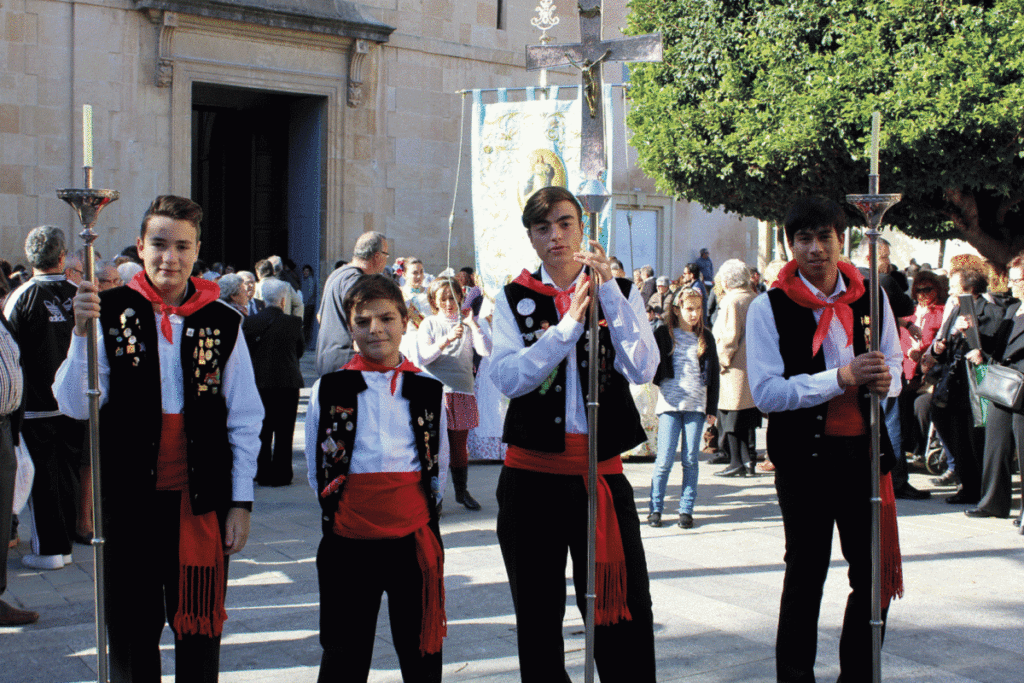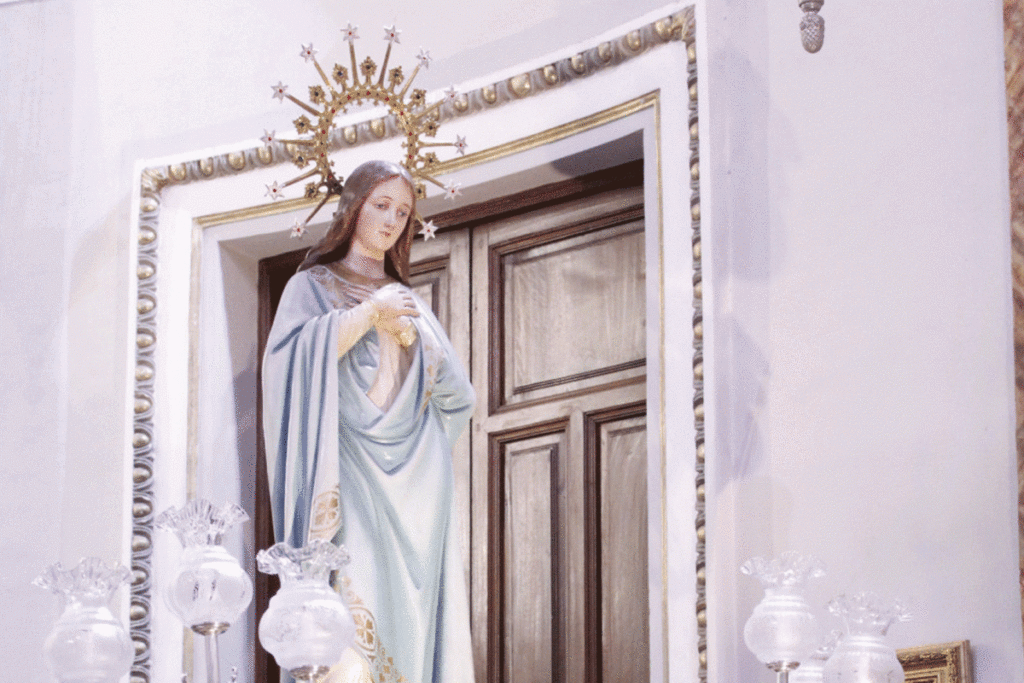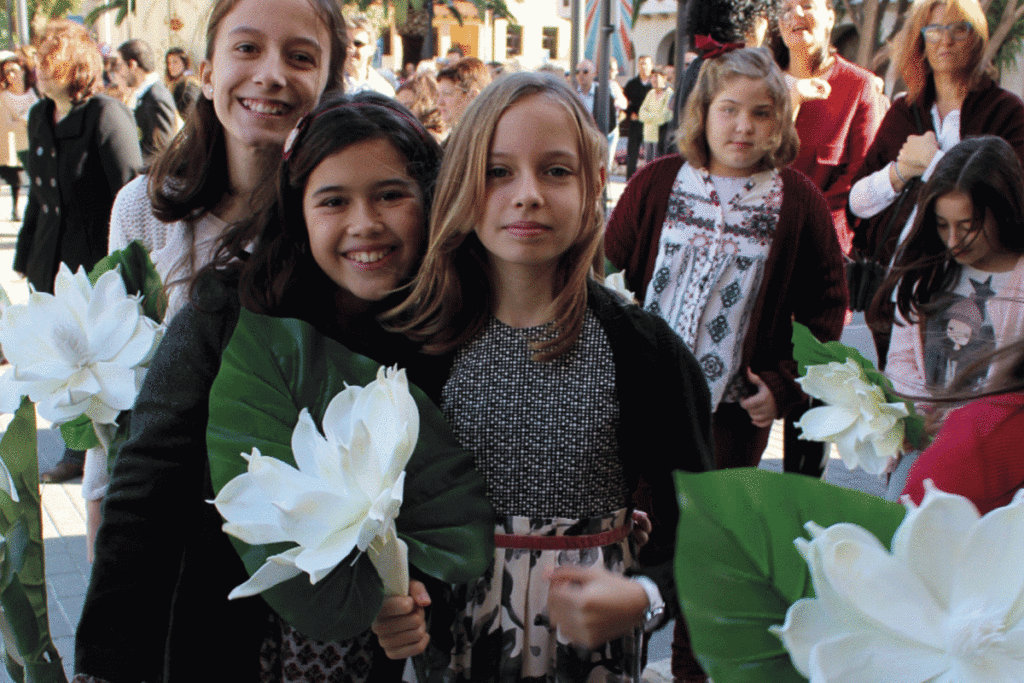Immaculate Conception
The feast of the Immaculate Conception is celebrated on December 8. It commemorates according to the dogma of the Catholic religion the virginal and sinless purity of Mary from her birth. This celebration appeared in the 12th century in Europe and became widespread in the 14th, although this devotion would not be declared a Dogma of Faith until 1854 by Pope Pius IX, within the framework of the First Vatican Council.
Of all the Marian festivals, the Immaculate Conception would achieve special interest in the lands of the Crown of Aragon since the Middle Ages, spreading to the rest of Spain. Among the first defenders of the dogma was Ramon Llull who, together with other philosophers and religious people, developed this religious idea and Marian devotion. Of all the kingdoms, that of Valencia was the most significant with the Immaculate Conception from the 14th century onwards. Some time later, the Jesuits, after their foundation, appeared as promoters of the Immaculate Conception and the kings of the Hispanic monarchy intensified their devotion in the 17th century, which led in 1674 to Alexander VII’s special privilege for Spain on the celebration of the Immaculate Conception. This continued dedication caused her to be declared the patron saint of Spain during the reign of Charles III.


The festival of this virgin is widely celebrated throughout Spain, whose day is still a holiday throughout the State, and on which until not many decades ago Mother’s Day was celebrated. In Sant Joan d’Alacant we do not know the date on which it began to be celebrated, but we know that the image of the Immaculate Conception has been safely venerated on different altars in the church since at least the 17th century, which makes it possible that this virgin was celebrated since ancient. In the 19th century, when the current church was built, one of its chapels was dedicated to the Immaculate Conception, carving an image by the sculptor Fons and a neo-Gothic altarpiece by Vicente Bañuls, which disappeared during the Civil War, both being replaced by similar replicas in the 40s. This was probably one of the peak moments of this Marian devotion that would increase in successive years until in 1913 the Congregation of the Daughters of Mary was created in Sant Joan, an association made up of women of all ages who were responsible for of the cult of the Virgin and of preparing the feast of the Immaculate Conception, among whose religious acts the evening procession stood out, in addition to the Novena and the masses.
Currently, the festival is still celebrated on the 8th and the days before with the Novena. On the 7th, the eve is celebrated with a vigil and on the day of the Immaculate Conception, a solemn mass takes place in the morning in which the Orfeón de Sant Joan participates and then the procession through the streets of the town with the image of the Immaculate Conception. on litters, accompanied by several people and the La Paz Musical Society, and all this, among the typical sounds of gunpowder and bells. In the celebrations, the typical blue color of this day is used, worn by priests and several participants in their clothing.

Also coinciding that this day is a holiday and on many occasions represents the continuation as a bridge of December 6, Constitution Day, other popular events are usually held such as craft markets, trade shows and local businesses or small fairs with performances. cultural events, activities that mark the beginning of the upcoming Christmas season with the town already decorated for them and the extraordinary lighting recently inaugurated.
Did you know that...?
In the chapel of the Immaculate Conception of the Parish ChurchYou can see the tombstone of the Torregrossa family that reads: ‘these are the arms and the grave of the Torregrosses, which are in the Old Church, First of the Conquest’ This family obtained burial rights in the primitive church after the Christian conquest of the 13th century, but when the new 17th century temple was built, the tombstones of the temple were destroyed, eliminating all traces of them. However, the Torregrossa family protested this fact, starting a lawsuit that they won, forcing the vicar general of the Diocese of Orihuela to replace the tombstone in 1631, which was placed in the chapel of the Inmaculada. In the 19th century, the central nave of the church was demolished again to build the current one, but on this occasion, the tombstone was respected, being moved to the new altar of the Immaculate Conception, in a different location than the previous one.
The Jesuits, main defenders of devotion to the Immaculate Conception of the Virgin, settled on the La Concepción de Sant Joan estate at the end of the 19th century. In 1889 Mrs. Concepción Pascual del Pobil Estellés, donated this house and attached gardens on her property to the Jesuit Order as a summer residence in exchange for the religious carrying out missions in the Huerta de Alicante.
Along with the Immaculate Conception, other Marian festivities were celebrated in Sant Joan d’Alacant, which currently have disappeared, such as the Assumption of the Virgin or the Virgin of the Rosary. The Assumption celebrated on August 15 remembers the Dogma of Catholic faith of assumption in body and soul and coronation of the Virgin. This devotion was very important since the Middle Ages, and most important churches in Europe were consecrated to it. In the ancient Kingdom of Valencia, it achieved great relevance, an example of which is currently the celebration of the Misteri d’Elx, declared a World Heritage Site, which is a sacred representation with medieval roots developed since the 13th or 14th centuries and evolved to the present day. . Processions were held in almost all places on this day. In Sant Joan d’Alacant, the morning procession was held with the recumbent image of the virgin adorned for this occasion with her best dresses and jewelry and surrounded by alábegas, plants that are typical of these dates. Currently the image of the virgin is placed on the main altar where it is visited by the neighbors, some of whom continue to compete to see which of their alábegas is the largest and most odorous. It can usually be seen in the chapel of the Virgin of the Rosary.
Another important Marian festival was that of the Virgin of the Rosary. It was celebrated in May and October and consisted of masses with a large orchestra with the participation of many musicians and a procession. Devotion for this virgin began in the 13th century following the appearance of the virgin to Saint Domingo de Guzmán, and the Dominicans founded by him would be the promoters of it. In Sant Joan d’Alacant, a chapel was built in the church to this virgin by the Vallebrera family in the 18th century, in which an artistic Churrigueresque altarpiece and their family tombs were installed. An attempt was made to recover this festival in the late 90s following the restoration of the Rosary chapel, however the attempt was unsuccessful, leaving the celebration restricted to the church. Some considered that this virgin was the ancient patron saint of Sant Joan d’Alacant but this statement has no historical basis.
